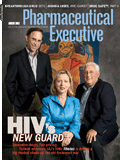Make Resistance Futile
Scare stories about antibiotic-resistant bacteria are all too common in the mass media these days. In the United Kingdom alone, the number of deaths from methicillin-resistant Staphylococcus aureus almost doubled between 2001 and 2005 to more than 2,000. The situation with Clostridium difficile is even worse, with UK deaths tripling to almost 4,000 over the same period. The big problem is that the incidence is growing, yet few antibiotics are being developed that will be able to kill the resistant bacteria.
Scare stories about antibiotic-resistant bacteria are all too common in the mass media these days. In the United Kingdom alone, the number of deaths from methicillin-resistant Staphylococcus aureus almost doubled between 2001 and 2005 to more than 2,000. The situation with Clostridium difficile is even worse, with UK deaths tripling to almost 4,000 over the same period. The big problem is that the incidence is growing, yet few antibiotics are being developed that will be able to kill the resistant bacteria.

Sarah Houlton
Now, the European Union is being urged to do something about the situation. The European Academies Science Advisory Council (EASAC) report Tackling Antibacterial Resistance in Europe provides a number of suggestions.
Currently, Big Pharma is doing very little research into new antibiotics. "R&D for new antibiotic drugs is not an attractive option for drug companies in comparison with treatments for long-term chronic illnesses, which offer a better return on investment," says Professor Volker ter Meulen of Germany's Leopoldina Academy of Sciences and chair of the report's working group. "Drug companies will need to be incentivized to continue valuable antibiotic R&D."
"Antibiotics are challenging to develop, so the industry is receptive to companies that come along with promising new ones," explains Professor Jeff Errington, a microbiologist at the University of Newcastle and chief scientific officer at Prolysis, a start-up focused on developing new antibiotics. "Getting to the point where industry becomes interested requires years of work and many millions of pounds of investment. It's difficult to see where that kind of funding will come from."
This is a real problem, and Errington—a member of the report's working group—believes a new funding model is needed, particularly in the early stages of drug development. "An academic may have a bright idea, but he needs to spend time and effort to get it to the point where industry starts to become interested. There's a major funding gap at that point—governments and charities will fund the very basic research but not the early-stage development. Venture capitalists don't really like to operate in that area either, as it's just too risky since the majority of compounds fail. Even when compounds are close to the development-candidate stage, the valuations that VCs put on them are ridiculously low."
The report states that more fundamental research into the mechanisms by which bacteria develop resistance is urgently required and that new drug targets need to be pinpointed to circumvent resistance pathways that already exist.
The report also calls for rapid diagnostics that make it much quicker to identify precisely which pathogen a patient has so that the right antibiotic can be chosen the first time. As Errington says, "Clinicians are often faced with patients who are at death's door. Even if there is a second-choice antibiotic to use on that bacteria, there may not be a second chance with the patient."
But, importantly, the report makes proposals about how the science base needs to be improved and how the European Commission and its member states can give concrete support to both academia and industry. Proposals include providing money for fundamental research, allowing extended patent protection for antibiotics, and giving R&D tax incentives, liability protections, and government guarantees to purchase certain quantities of the products. Small companies should receive targeted help to close the funding gap that makes it difficult for them to advance into full development.
The report also suggests that regulator European Agency for the Evaluation of Medicinal Products can help by updating its guidelines on clinical trials and encouraging innovative trial design, plus giving new antibiotics accelerated priority-review status and conditional approval based on Phase II data allied to postmarketing studies.
"The problem is that the rise of resistance to antibiotics is nonstop—as fast as we introduce them, the bugs start to become resistant," says Errington. "Clinicians are gradually running out of options; we need to be working now to create the next generation of antibiotics."
Sarah Houlton is Pharmaceutical Executive's global correspondent. She can be reached at sarah@owlmedia.co.uk
FDA Grants Priority Review to Regeneron’s Eylea for Macular Edema Following Retinal Vein Occlusion
April 18th 2025Regulatory action was based on data from the Phase III QUASAR trial, which demonstrated that Eylea HD dosed every eight weeks achieved non-inferior visual acuity outcomes compared to Eylea in patients with macular edema following retinal vein occlusion.
Addressing Disparities in Psoriasis Trials: Takeda's Strategies for Inclusivity in Clinical Research
April 14th 2025LaShell Robinson, Head of Global Feasibility and Trial Equity at Takeda, speaks about the company's strategies to engage patients in underrepresented populations in its phase III psoriasis trials.
New Insights Into T Cell Exhaustion and Inflammation in Long COVID
April 17th 2025Nigel McCracken, chief operating officer, Virax Biolabs, discusses new findings that reveal altered cytokine activity and evidence of T cell exhaustion in long COVID patients, providing deeper insight into post-infection immune disruption.
Key Findings of the NIAGARA and HIMALAYA Trials
November 8th 2024In this episode of the Pharmaceutical Executive podcast, Shubh Goel, head of immuno-oncology, gastrointestinal tumors, US oncology business unit, AstraZeneca, discusses the findings of the NIAGARA trial in bladder cancer and the significance of the five-year overall survival data from the HIMALAYA trial, particularly the long-term efficacy of the STRIDE regimen for unresectable liver cancer.
Amgen’s Imdelltra Demonstrates Significant Overall Survival Improvement in Small Cell Lung Cancer
April 16th 2025In the Phase III DeLLphi-304 trial, patients with small cell lung cancer administered Imdelltra achieved a statistically significant and clinically meaningful improvement in overall survival compared to standard-of-care chemotherapy.
